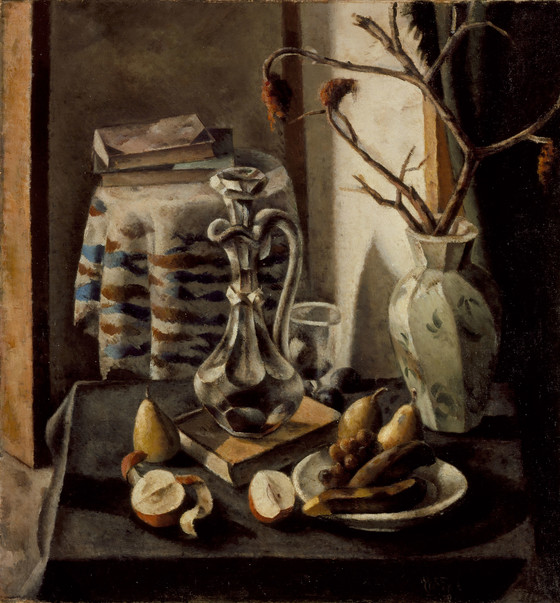McFee’s tabletop still lifes remained consistent throughout his career....
McFee’s tabletop still lifes remained consistent throughout his career. They always contain the same basic components: a wood table that is tilted toward the viewer, and often draped with some fabric, with an array of objects atop it. An assortment of fruit, arranged around and on plates or in other containers, was usually placed near a potted plant or vase of flowers, as in Still Life with Carafe. After the 1910s McFee’s still lifes often featured a glass object, no doubt because the reflective and transparent qualities of the glass enabled him to explore his modernist fascination with forms and planes. The faceted, cut-glass decanter in the museum’s painting seems to have been especially appealing to the artist, for he used it in several other still lifes of the 1930s. The arrangement in the museum’s painting is slightly more elaborate than in most of his other compositions, since, following an old still-life tradition, McFee presented both whole and cut fruit. He also included in the background of this painting a second table with books placed on it.
Although McFee’s still-life compositions of his mature years appear more traditional than his early abstractions, they continue to demonstrate the artist’s fundamental loyalty to Paul Cézanne (1839-1906). In the use of a simple table, the type of still-life arrangement, and an emphasis on cubic form, McFee followed Cézanne’s example, but he gave a greater sense of depth to the overall scene. His mature still lifes also reveal his personal exploration of painting techniques. As did Dasburg, McFee presented his objects not in flat, opaque planes but in layers of delicately brushed pigments that give a soft, almost shimmering quality to his surfaces. The objects appear both solid and delicate. In Still Life with Carafe the overall gray tonality is infused with a wealth of other colors-deep green, alizarin, warm brown, and orange-that are repeated throughout. The overall appearance of a McFee painting is one of great sensuality.
More...
